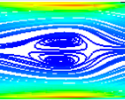Non-uniform magnetic field
Magneto-Hydro-Dynamics (MHD) effects associated with a non-uniform
magnetic field have the capacity to significantly modify the fluid
velocity profile and to induce flow instabilities that affect mass
and heat transfer as well as corrosion rates
...
Buoyant jet
Flows arising from thermal buoyancy are frequently encountered in many environmental
and man-made systems. In most cases buoyant flows are highly turbulent and often unstable.
Moreover, far from the buoyancy source relaminarisation of turbulent flow can also occur
...
Fire in a enclosure
Fire in an enclosure is an example where the overall combustion rate is
controlled by ventilation conditions. Flow of fresh air and combustion products in an enclosure
has a significant bearing on the development and state of fire
...
Wall boiling
Boiling is one of the most effective heat transfer mechanisms. The ability
to accurately predict such phase change phenomenon is of great importance
in process and power generation industries. Although most commonly used,
boiling in water flow represents a significant challenge
...
Kelvin-Helmholtz instability
The Kelvin-Helmholtz instability develops at the interface between two fluids
that are moving at different velocities. Small interface deformations
influence the local pressure distribution, which may amplify the initial
deformations. Shear forces between both fluid flows distort the initially
...
Turbulent flow separation and reattachment
Flow separation occurs in many aerodynamic flows of interest: airfoils, road vehicles,
HVAC equipment, and in built environment. It leads to loss of lift, increase of drag,
and in general causes pressure losses that cannot be recovered
...
Poiseuille flow near the wall
In the turbulent flow regime, the transfer between the wall and the flow is
characterized by a thin viscosity dominated sublayer. Its correct approximation
is challenging for most of the turbulence models, which have been developed and
tuned for free stream decaying turbulence
...
Laminar, isothermal backward facing step
Flow across a backward facing step in laminar flow regime that is associated with
flow separation and reattachment. It is one of most studied validation cases
mostly because of its simple geometrical arrangement and lack of adequate analytical
solution of the flow field
...
Channel flow with viscous heating
Flow of highly viscous fluid, where shear importantly contributes
to the overall energy balance. Such viscous heating that is often characterized
by Brinkman number has to be taken into account has to be taken into account
in polymer processing as well as in food process industry
...
Convective heat transfer
Investigation of the extent of false numerical diffusion associated
with discretisation of the momentum and the energy equation convection terms. The
introduced numerical error is manifested by the accelerated growth of the momentum
and thermal boundary layer, which increases the boundary layer thickness
...
Hartmann layer
Flow of an electrically conductive fluid across a magnetic field
induces an electric current. The resulting Lorentz force may profundly
affect the flow behaviour. Examples of such magneto-fluid dynamics
occur in plasmas, liquid metals, molten salts and electrolytes
...
Oscillatory motion of viscous boundary layer
Analysis of the transient solver accuracy and the extent of false numerical
diffusion by comparing the velocity distribution throughout the simulation
time interval with the analytical solution. The numerical error is manifested
by the accelerated velocity decay and the phase shift of the oscillatory motion
...
Numerical grid deformation
Test of the grid deformation capability by examining the extent of permanent
element deformation due to periodic boundary displacement. Minimal face angle of
all control volumes in the simulation domain can be used to characterize
performance of the grid deformation algorithm
...













